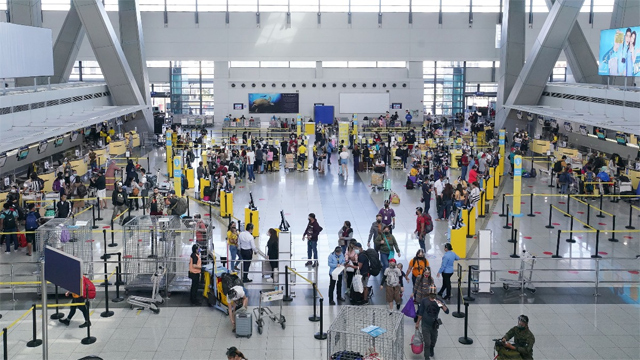
Now that lockdowns are over, and more people are engaging in revenge travel, the airline industry is challenged to find ways to streamline their airport operations. According to the International Civil Aviation Organization (ICAO), the aviation sector is growing fast—even after struggling during the pandemic. It’s estimated that the demand for air travel will increase by an average of 4.3% per annum over the next 20 years.
To keep up with this growth, airports need to make several improvements to not only optimize their procedures but also give travelers a positive airport experience. Let’s take a look at six airport improvement projects that many airports have implemented or plan to implement to achieve their goals:
Implementation of Smart Airport Technologies
Smart technologies can be used to automate a wide spectrum of airport services and procedures, from check-in to boarding. With the proper use of these solutions, airports can enhance certain areas in their operations to suit their unique needs.
For example, the Mactan-Cebu International Airport (MCIA) in the Philippines will receive some technological upgrades that will transform it into a smart airport. It plans to implement several smart solutions, such as luggage tracking, to improve and maximize the customer experience throughout its facilities.
Other airports are currently using or looking into the following smart technologies::
- Smart Check-ins. Some airlines and airports are collaborating to offer online check-in options through their websites and mobile apps. With these apps, passengers can select seats, check baggage, and receive their boarding passes electronically. At some airports, dedicated kiosks are available for self-service check-ins, reducing the need for traditional check-in counters. With this technology, travelers can enjoy the flexibility of checking in from the comfort of their homes or offices, saving precious time at the airport.
- Automated Bag Drop and Tracking Kiosks. These kiosks allow passengers to check their luggage with minimal human interaction. Once their luggage is checked in, they’ll receive real-time baggage tracking information, often accessible through the airline’s app. This ensures more efficient luggage handling and reduces the risk of lost or mishandled baggage, bringing passengers peace of mind.
- Self-Boarding Gates. To speed up the boarding process and enhance security, many airports have implemented self-boarding gates in their operations. Using integrated biometric technology, such as facial recognition and fingerprint scanning, passengers can simply scan their faces or fingerprints at the gate for quick and secure boarding.
- AI Integration. Artificial intelligence is playing a significant role in improving the passenger experience. Airlines and airports have developed AI-driven chatbots and information systems to provide real-time updates to assist passengers with common queries and offer guidance throughout the journey.
Improved Transport Connectivity
Travelers are always looking for the fastest and most convenient ways to get to the airport. Creating an efficient transport connectivity system that addresses these needs can help ensure that passengers can make it to their flights without hassle. To do this, airports often collaborate with local governments and transportation authorities to improve road, rail, and public transportation links. These projects are typically part of larger urban development plans, focusing on better access to airports. By implementing a multimodal transportation strategy and implementing key elements, such as well-organized shuttle services and airport rail links, travelers can access the airport without worrying too much about traffic congestion or complex transfers.
Improved Wayfinding and Passenger Flow
Navigating a large airport can be a daunting task, but improvements in wayfinding are changing this. Modern solutions, like interactive map displays, can promptly direct travelers to where they’re supposed to go, increasing passenger flow. Some airports also use data analytics to monitor passenger movements within their facilities, allowing them to make adjustments for a smoother journey. With these strategies, passengers can navigate large and sometimes complex airport layouts with ease, giving them peace of mind.
Enhanced Lounges
Travelers pay a premium to access airport lounges. Thus, they expect these facilities to provide them with exclusive amenities to make their stay at the airport more enjoyable and comfortable. Most airport lounges offer comfortable seating, quality dining options, bar and refreshments, as well as showers and restrooms. However, some airports have made enhancements to their lounges to provide their customers with a unique experience. Some examples of these improvements include:
- Sleeping Pods. Instead of sprawling across the airport seats to get some shut-eye, travelers can use sleeping pods instead. These specially designed capsules provide travelers with a comfortable environment where they can get restful sleep before their flight in private.
- Quiet Workspace. Creating a quiet workspace that has comfortable workstations, ample power outlets, and good lighting provides business travelers with a place where they work in peace.
- Wellness Facilities. Adding wellness facilities, like yoga rooms, tranquility spaces, and spas, can help passengers relax and rejuvenate while they’re waiting for their next flight.
Better Internet Connection
Airport management understands that access to high-speed internet is a priority for travelers. With this concern in mind, they’re upgrading their Wi-Fi infrastructure to offer fast and reliable internet access. Airports are working closely with internet service providers so that their facilities have adequate bandwidth and coverage to support the thousands of people they serve. This collaborative effort ensures that passengers can stay connected with ease, whether they need to work, communicate, or simply be entertained.
Swift But Robust Security Procedures
While traditional airport security measures maintain passenger safety, they can cause inconvenient bottlenecks. Manual processes like the removal of personal belongings and frisking are time-consuming, which is why many airports have implemented efficient yet robust security systems to speed up the process of going through security. Advanced technologies, including CT scanners and automated screening lanes, are being adopted to make security checks faster and less intrusive. Thanks to these modern systems, passengers can experience quicker security checks while security agencies maintain high standards of safety and vigilance.
As the demand for air travel increases, airports and airlines need to make the necessary improvements to handle the influx of passengers. They have to implement efficient and modern solutions to ensure that they’re providing their customers with a seamless airport and travel experience. That’s precisely why many airports have completed or are planning to integrate some of the projects mentioned in this list. With these and other emerging solutions, airports can future-proof themselves and continue to thrive despite the mounting challenges presented by the dynamic and competitive air travel industry.








